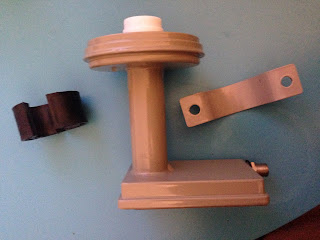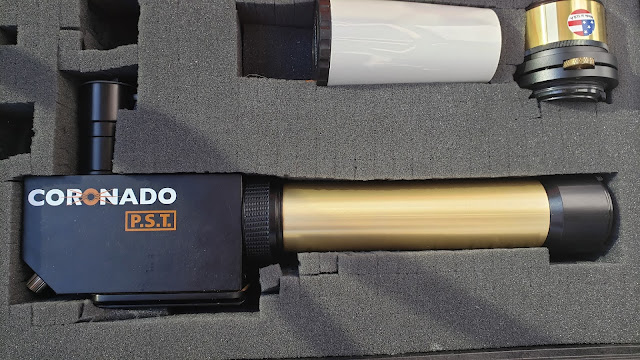Itty Bitty Radio Telescope Dish Measurements
The LNB I purchased for my Itty Bitty Radio Telescope has a neck on it that allows adjustment of where it is positioned in the dish. I want to position the LNB in the best spot for the dish. I decided to do some reading and some measurements and calculate the best spot in the dish for the LNB to be positioned. This will also help any further uses of the dish because I might have to modify the support brackets.
The first website I came across that had the information I was looking for was this website. It was pretty well laid out, and this picture provides a nice visual for what I want to measure.
I measured the distance D on my dish. Since I bought a 1.2 meter dish, I was not surprised that this number came out to be just a tiny bit over 120 cm.
To measure the c distance, I stretched string across the upper lip of the dish and used a metal ruler to measure the depth of the dish at the very centre. I found c to be 19.5 cm.
Using those measurements and this website to do the calculations for me, I found that my dish has an f/D ratio of 0.38, and the focal point is located 46.2 cm above the centre of the dish.
I measured my dish from the centre of the dish to the bracket that holds the LNB and found that measurement to be 46.2 cm to the bottom of the bracket that holds the LNB.
As you can see in the picture above, the LNB is not being held tightly in the holder, so it slides down the whole length of the neck and ends up not in the optimal position. To remedy this, I put some tape around the black plastic piece that fits between the LNB and the curved brackets.
Once everything was fitting snug, I reinstalled the LNB at the distance I measured. I couldn't get it exactly, but I was able to get it much closer than it was before.
The next thing I needed was a way to know where my Itty Bitty Radio Telescope is pointed. Luckily for me, the base of the satellite dish is kind of like a tripod with the dish elevation controlled by an adjustable length rod.
I borrowed a digital bevel box that is used to measure angles. I zeroed it on the base of the dish, and measured the angle of the dish relative to the base. I put a major gradient mark every ten degrees and a minor mark every five. This should allow me to point my telescope in roughly the right angle. I suspect my telescope will have a fairly large beamwidth, so the five degree markings should be sufficient.
The first website I came across that had the information I was looking for was this website. It was pretty well laid out, and this picture provides a nice visual for what I want to measure.
I measured the distance D on my dish. Since I bought a 1.2 meter dish, I was not surprised that this number came out to be just a tiny bit over 120 cm.
To measure the c distance, I stretched string across the upper lip of the dish and used a metal ruler to measure the depth of the dish at the very centre. I found c to be 19.5 cm.
Using those measurements and this website to do the calculations for me, I found that my dish has an f/D ratio of 0.38, and the focal point is located 46.2 cm above the centre of the dish.
I measured my dish from the centre of the dish to the bracket that holds the LNB and found that measurement to be 46.2 cm to the bottom of the bracket that holds the LNB.
 | |
| The bottom of the curved brackets were found to be 46.2 cm above the centre of the dish |
As you can see in the picture above, the LNB is not being held tightly in the holder, so it slides down the whole length of the neck and ends up not in the optimal position. To remedy this, I put some tape around the black plastic piece that fits between the LNB and the curved brackets.
Once everything was fitting snug, I reinstalled the LNB at the distance I measured. I couldn't get it exactly, but I was able to get it much closer than it was before.
The next thing I needed was a way to know where my Itty Bitty Radio Telescope is pointed. Luckily for me, the base of the satellite dish is kind of like a tripod with the dish elevation controlled by an adjustable length rod.
I borrowed a digital bevel box that is used to measure angles. I zeroed it on the base of the dish, and measured the angle of the dish relative to the base. I put a major gradient mark every ten degrees and a minor mark every five. This should allow me to point my telescope in roughly the right angle. I suspect my telescope will have a fairly large beamwidth, so the five degree markings should be sufficient.
 | |
| Marking in progress. The bevel box is attached on the left. |
 |
| Marking complete. My scale is visible. Now I should be able to tell where my dish is pointed. |






Comments
Post a Comment